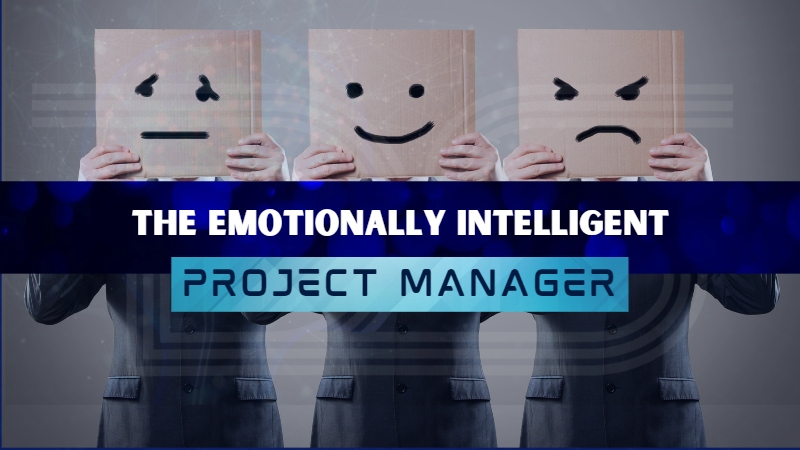
by Dharam CW2 | May 19, 2023 | General
Emotional intelligence in the workplace is becoming increasingly important for leaders and project managers as remote work became more prevalent due to the pandemic. Success in project management and managing cross-functional remote teams is only possible with emotional intelligence.
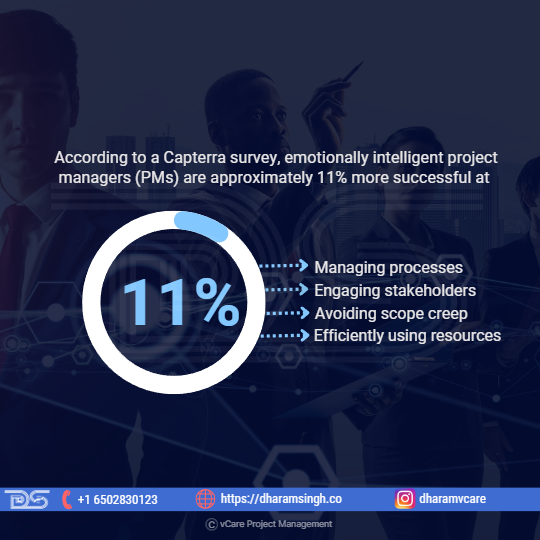
Capterra Survey
According to a Capterra survey, emotionally intelligent project managers (PMs) are approximately 11% more successful at managing processes, engaging stakeholders, avoiding scope creep, and efficiently using resources than PMs who lack this skill.
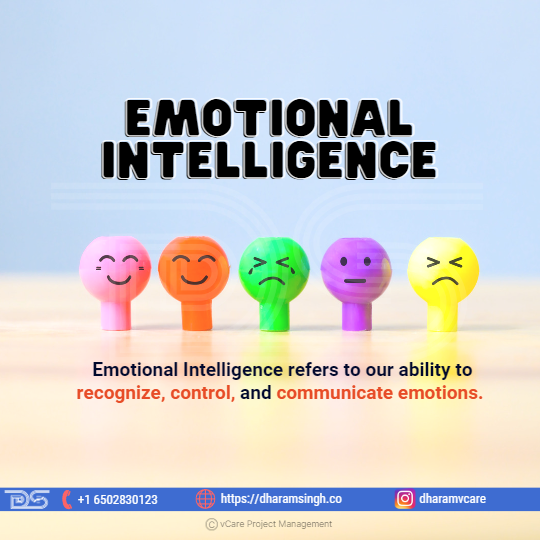
Emotional Intelligence
What is Emotional Intelligence?
Emotional intelligence refers to our ability to recognize, control, and communicate emotions. People with high emotional intelligence understand how they feel, what their feelings imply, and how their feelings affect others. In interpersonal situations, it is also the ability to empathize with others. Emotional intelligence is about creating a positive work environment, which is critical to the success of any project.
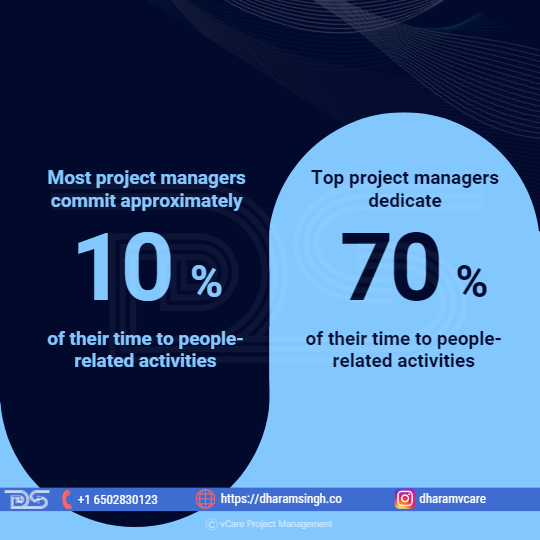
As Per LiquidPlanner Study
According to a LiquidPlanner study, most project managers commit approximately 10% of their time to people-related activities. Top project managers dedicate 70% of their time to these activities. As a result, we can conclude that emotional intelligence is crucial for project success.
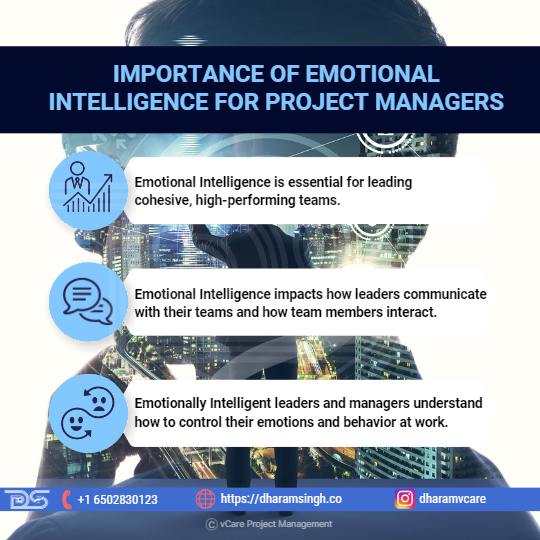
Importance of Emotional Intelligence for Project Managers
Importance of Emotional Intelligence for Project Managers
- Emotional intelligence is essential for leading cohesive, high-performing teams.
- According to researchers and behavioral scientists, Emotional intelligence impacts how leaders communicate with their teams and how team members interact.
- Emotionally intelligent leaders and managers understand how to control their emotions and behavior at work, which includes providing safe environments for exchanging ideas and feedback, productive teamwork and performance, good morale, employee engagement, and job satisfaction. They manage workplace stress and conflict with care and educate their team members to do the same.
Characteristics of Emotional Intelligence
What can project managers do to help themselves develop and become more aware? First, let’s examine five abilities for raising emotional intelligence:
- Self-Awareness – The ability to sense, identify, and comprehend emotions is self-awareness. Unfortunately, many of us were taught to ignore our emotions in the past. However, it is critical to be aware of your feelings to make appropriate decisions and act accordingly. Those with high self-awareness are self-assured, authentic, open to feedback, and capable of maintaining perspective throughout all project phases.
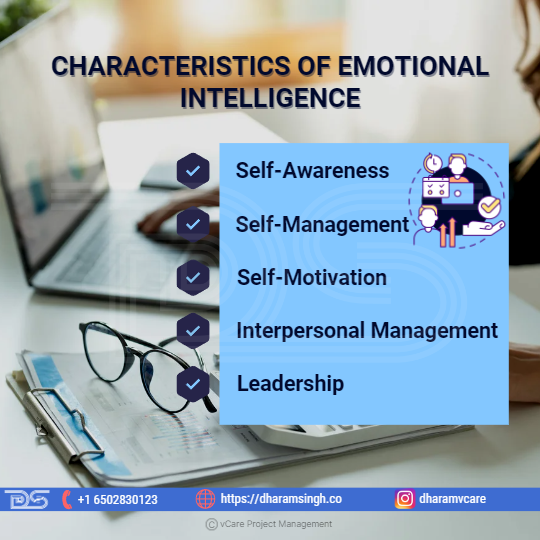
Characteristics of Emotional Intelligence
- Self-Management – Self-management is the ability to reason well while understanding feelings. Many frequently react based on their frame of reference rather than selecting a response based on their current unique circumstances. Self-managers are deliberate in decision-making, taking the initiative, framing events appropriately, maintaining perspective, and responding quickly. They understand their feelings and why they have them and effectively manage their responses.
- Self-Motivation – Self-motivation is the ability to channel the power of your emotions toward a specific goal. When project teams have a purpose, these ‘P’s follow peace, passion, power, perspective, and potential leverage. Self-motivators who are influential are optimistic and have a positive attitude. They can delay gratification and assert themselves.
- Interpersonal Management – The capability to identify and respond properly to the emotions of others is referred to as interpersonal management. If you can connect with people and acknowledge their humanity, they will answer openly, leading to common trust.
- Leadership – An emotionally intelligent project manager inspires guides, challenges, and supports the team. Leadership is defined as the ability to create and communicate vision and passion for assisting individuals and organizations in reaching their full potential.
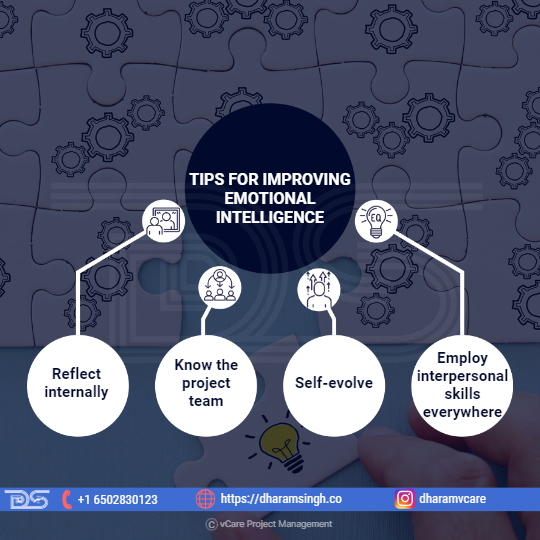
Tips for improving Emotional Intelligence
Tips for improving Emotional Intelligence
- Reflect internally – To become more emotionally aware, one must first understand their emotions and then regulate them in stressful situations. Next, they have to figure out what motivates them. Finally, authenticity is necessary to develop emotional intelligence by leading a successful project team and establishing meaningful relationships with stakeholders.
- Know the project team – Project managers are usually aware of the people they must contact when working on a project. However, understanding the project team, from team dynamics to personalities to dealing with conflict and stress, is just as important. To improve emotional intelligence, one must first get to know their team, communicate with them, and understand their emotions. It will also help the success of their project. This job becomes even more important for teams that operate in multiple locations and are diverse.
- Self-evolve – Along with other important leadership talents, project managers should work to improve their emotional intelligence regularly. Conditions surrounding a project frequently change; its scope may shift, the number of stakeholders may increase, and projects may eventually end.Every project is distinct, and no project manager can complete a project independently. Therefore, it is advantageous for project managers to consider what they learn during and after a project. For example, consider how a project team operated, what they witnessed during critical times with stakeholders, and their team’s performance.
- Employ interpersonal skills everywhere – Emotional intelligence can be helpful in almost any project management situation. For example, people may feel compelled to sign off on a strategy to minimize delays while managing scope changes or project risk. Following the resolution of such issues, an emotionally intelligent project manager would pursue people because they notice that this could lead to more severe problems in the future.
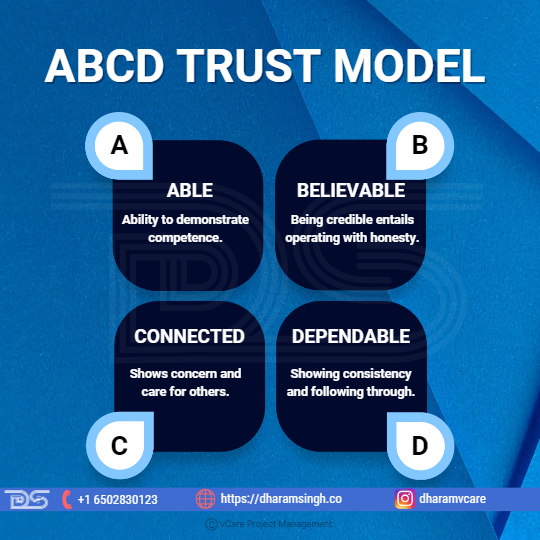
ABCD Trust model
ABCD Trust model
Better relationships will result in better outcomes. That is why developing trusted connections is critical to the success of your organization. When individuals trust one another, they may work efficiently together.
It is well known that low trust harms morale, productivity, and turnover. To prevent these traps, Ken Blanchard created the ABCD Trust Model to help executives understand the activities that affect creating trustworthy relationships.
Blanchard suggests four critical aspects for leaders to develop trust with people: Able, Believable, Connected, and Dependable.
- Able – The term able refers to the ability to demonstrate competence. Leaders demonstrate competence by possessing the necessary skills, education, credentials, and experience. They also exhibit their capacity to lead by accomplishing achievements. Able leaders can encourage people and collaborate with them to achieve goals.
- Believable – Being credible entails operating with honesty. Believable leaders adhere to a set of core beliefs. They know what they stand for and will not compromise their principles under pressure. Being credible also means maintaining promises and not lying or stretching the truth.
- Connected – Connected shows concern and care for others. This aspect fosters trust and contributes to a more engaged workplace atmosphere. Being linked entails attending to people’s needs and promoting their well-being. Leaders also build relationships by giving information not only about the organization but also about themselves. Employees are significantly more likely to provide their best effort when they feel linked to leaders.
- Dependable – Dependable means showing consistency and following through. It entails holding oneself and others accountable for commitments. A trustworthy leader will accept responsibility for their acts and help their followers face adversity.
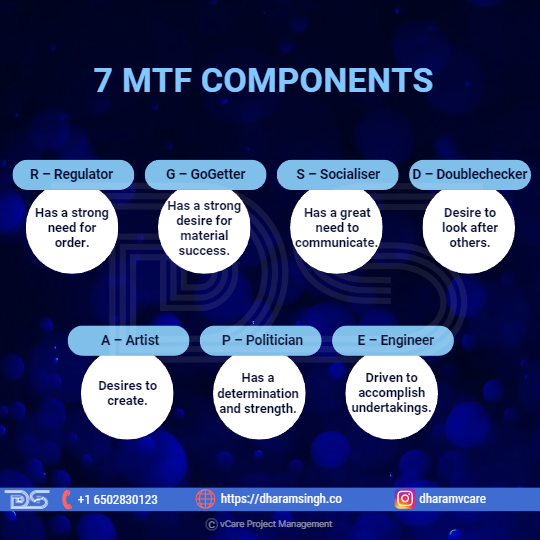
7MTF Components
7MTF Components
The 7MTF model is composed of seven components. We all have all 7 in our personalities; as adults, 2 to 4 will be strong, some will be weak, and others will be ordinary. This mix of elements is one of the most significant variables in deciding our temperament – our emotional predisposition.
- The R – Regulator (formerly known as the Normal) – A person with a ‘strong R’ has a strong need for Order. They will be mature, responsible, calm, and emotionless. You may hear the words ‘should,’ ‘ought,’ and ‘logical’ in their language. They have high expectations of themselves and others, including those with whom they live and work.
- The G – GoGetter (formerly known as the Hustler) – A person with a ‘strong G’ has a strong desire for material success. This individual entails enjoying money and the things it can purchase. The G is quick, opportunistic, intelligent, enterprising, and charming. They are short-term in nature, expecting results immediately or very soon. Promising a G a large monetary reward next year is unlikely to pique their attention.
- The S – Socialiser (formerly known as the Mover) – The ‘strong S’ personality has a great need to communicate. This aspect implies talking about people, fun, events, what you did over the weekend, or anything related to life. Hence, their straightforward, friendly, and frequent grin immediately.
- The D – Doublechecker – The ‘strong D’ is characterized by a desire to look after others and ensure everyone is safe. When you encounter a strong D, expect someone obedient, loyal, and concerned with doing the right thing. One of their greatest assets is their ability to anticipate difficulties and hazards.
- The A – Artist – A person with a ‘strong A’ desires to create. “I want to be different,” is what they would say. These hardworking individuals are conscientious and do not wish to offend anyone. Seek for anything unusual about their attire, such as innovative earrings, cufflinks, a six-button jacket, or an all-black ensemble!
- The P – Politician – A solid handshake and direct eye contact indicate that the ‘strong P’ is determined to win. This person has a determination and strength that others may find challenging. The spoken word is the strong P’s stock in trade – look for status markers like the huge Mercedes in metallic blue.
- The E – Engineer – A person with a ‘strong E’ personality is driven to accomplish undertakings. The strong E has traits such as process, detail, and procedure. This individual can form a strategy and make it happen as soon as they see anything. The E is concerned with completion. So, unless you can assist, you should avoid getting in the way!
Wisdom – strive for mental stability and individual resilience – 10 Competencies
Wikipedia defines wisdom as the “ability to contemplate and act using knowledge, experience, understanding, common sense, and insight.” Psychologists have created a list of ten competencies that are typical therapies in their field and are referred to as wisdom. Self-awareness, self-control, and empathy are the three components of emotional intelligence (EI). Although the fourth component of EI is not formally mentioned among the ten competencies, social influence or influencing others may be considered a result of being highly effective in the other areas.
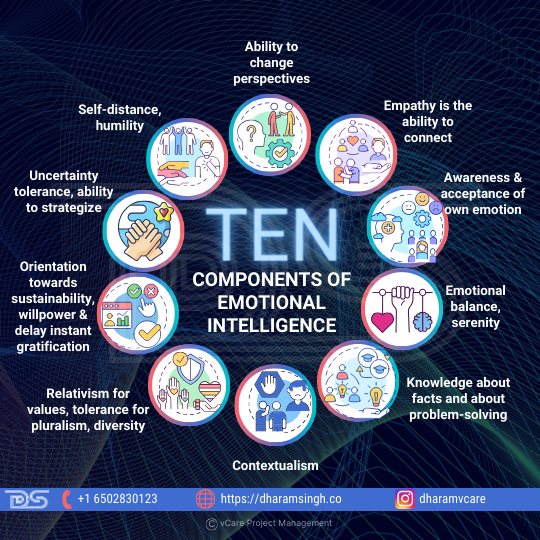
Ten Components of Emotional Intelligence
- Ability to change perspectives – In a bipolar environment, it is possible to remain trapped in one thought and dislike the other viewpoint with strong emotions, which may lead to violence. The ability to look for and identify more points of view implies a shift in viewpoint. Some of the therapies used to treat mental illnesses can help with this. Examples include role-playing, acting, visiting people in various countries, learning about diverse cultures, and brainstorming.
- Empathy is the ability to connect – Understanding people’s intentions, current state of mind, emotions, and mindsets is necessary for being heard, establishing trust, and influencing others. In addition, active listening techniques may help you focus outside yourself and view others as humans who vary from ourselves.
- Awareness & acceptance of own emotions (self-awareness) – Self-awareness leads to increased self-confidence and sincerity. It refers to mindfulness, or being aware of one’s feelings, and is required for self-control and emotional balance.
- Emotional balance, serenity (self-control) – Patience, serenity, and avoiding knee-jerk reactions make you more popular and respected and contribute to mental tranquility. Having a mentor can help you develop and fine-tune this skill.
- Knowledge about facts (know what, assimilation) and about problem-solving (know-how, accommodation) – Wisdom includes knowledge; therefore, it has two components.
- On the one hand, we have factual knowledge about a topic; on the other, we may be specialists in a (typically technical) area. This heuristic knowledge and assimilation are how we apply established systems to circumstances.
- On the other hand, when we encounter new situations or topics, we use accommodation to apply our problem-solving skills. We employ our epistemic intelligence and heuristics to do this.
- Contextualism (consider the situation, timeline, and social relevance) – Even though we have theories and may find similarities in new scenarios, each situation is unique and depends on the circumstances, the context in which the problem develops, and the societal importance. This capacity is achieved via awareness and avoiding picking a solution that works in another context without first examining the present dependencies of the situation.
- Relativism for values, tolerance for pluralism, diversity (which is hard if you are part of the same belief systems for most of your life, like nations and churches) – There are many truths (this is known as non-monism), and yours is only one of them. Others have the right to their realities, which are based on the cultures in which they live, their beliefs and experiences, and the facts to which they have access. Value relativism allows one to accept and appreciate the values of others.
- Orientation towards sustainability, willpower, and delay instant gratification (perspective of linear and circular time flow) – We can pursue long-term goals and make decisions with both short and long-term consequences in mind.
- Uncertainty tolerance, ability to strategize (imaging solutions for scenarios) – Accept that life is unpredictable and swim through it like a river, adapting to currents and waves as they come.
- Self-distance, humility – Do not believe you are the center of the universe, which will remain when you die. Avoid being a taker rather than a giver by avoiding jealousy, bragging, pride, and greed.
Final Thoughts
For today’s project managers, emotional intelligence is a critical concept. Many companies are looking for project managers with strong technical and soft skills. Emotional intelligence is crucial in project management because it enables project managers to improve communication and collaboration in the workplace. It is essential to mention that emotional intelligence can be imparted and nurtured. This aspect implies that as a project manager, one can better oneself by controlling feelings and emotions and developing positive behaviors to influence others at work. One will make better decisions about other people’s emotions, strengths, and weaknesses once they have recognized their thoughts.
Feel free to check out my discussion on this topic with Thomas Walenta in YouTube
For any questions related to your Project Management career, training, and certifications, you can book an obligation free 15 minutes session with me by visiting http://talktodharam.com/
You can subscribe to the vCare Project Management YouTube Channel to catch future videos of our Q&A series and certification success stories: https://bit.ly/2YF0wJl
You can subscribe to and follow my podcasts and interviews with Project Management Experts on YouTube at https://bit.ly/2NDY8wd
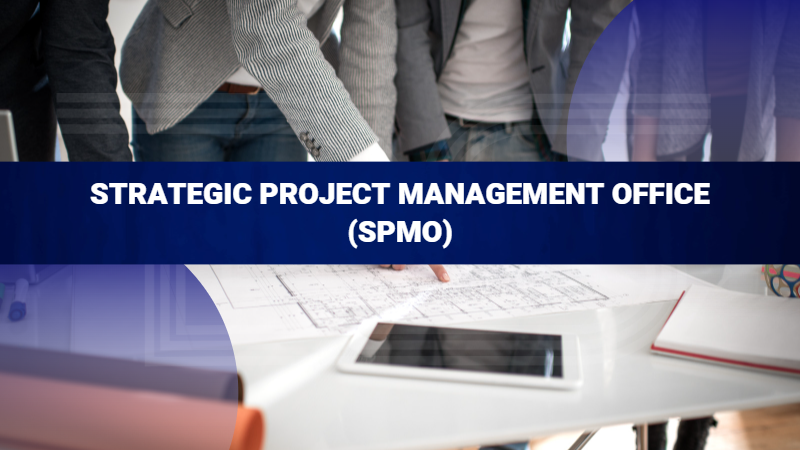
by DharamCW | May 7, 2023 | General
The project management office (PMO) is increasingly evolving from an administrative role to one that is strategic and more closely connected with business drivers. As a result, the PMO plays an important role in generating corporate value as the pace of business rises along with the expectation of faster returns on investment.
Traditional administrative PMOs fall short of meeting this need. Therefore, a mindset change and a reinvented project delivery capability that is both commercially astute and agile are required. Furthermore, such a PMO must comprehend and implement the plan.
In this article, we’ll look at the factors driving the shift to strategic project management offices (SPMO), also known as Enterprise PMO or EPMO, the essential features of a value-adding PMO, and game changer ideas to help you alter your PMO and improve its profile in your business.

What is Strategic PMO (SPMO)?
Strategic PMO (SPMO)
A Strategic PMO is a project-centric business department that should be structured and managed like other business departments – with enterprise leadership setting goals and objectives that assist the organization in thriving. The demands of individual organizations will lead to variations in what it means in specific terms. Still, we can expect a focus on the following areas:
- Portfolio management – Generation of ideas, selection, execution, and realization of benefits. Portfolio Management is a huge area, and organizations will adapt to it as it becomes increasingly crucial.
- Financial management – The PMO, closely linked to portfolio management, must be accountable for ensuring that project investments are acceptable and fit with business goals. The PMO must also guarantee competent budget management during project execution. Furthermore, the PMO should be held accountable for monitoring and tracking the benefit realization tasks of the business units.
- Enterprise-wide project-related processes and approaches Strategic risk management (i.e., managing the portfolio’s organizational risk exposure, proactive risk selection to match organizational tolerance, and so on), integration of finance and benefits, consistent quality standards, and so on.

Focus areas of Strategic PMO
- Proactive resource management – Capacity and capability planning, skills inventory management, and so on – ensuring that the project execution functions have the appropriate people with the right skills at the right time.
- Strategic partner – This borders on cultural change, creating the PMO as an independent and impartial consultant to the organization on project execution. PMOs, like IT, must demonstrate that they are business leaders supporting the organization’s work rather than a tactical execution-only function.
Different levels of PMO strategic alignment
Within an organization, a PMO can function at three stages of ‘Strategic’ maturity:

Different levels of PMO strategic alignment
- Strategy Creation – Strategy Creation entails assisting organizations in determining which strategic options to pursue (and then translating them into projects – Strategy Delivery – and managing their success – Strategy Management). It is unusual for a PMO to achieve this level of trust and influence inside an organization. Still, it is the (possible) future for the enterprise PMO that is effectively embedded within an organization and fortunate with the right sponsorship.
- Strategy Delivery – Strategy Delivery is the process through which the PMO turns important strategy objectives into new projects to be added to the portfolio (and perhaps to remove some from the portfolio if such objectives have changed). The ‘Strategy Supervision’ capability backs up this ‘Strategy Delivery’ capability. The PMO may also take direct responsibility for the execution of large and complex programs (or projects) that are specifically critical to a key strategic effort, such as relocation activities.
- Strategy Supervision – Strategy Supervision of strategic intents through project ownership, each of which should directly or indirectly link to a strategic intention of the overall organization. ‘Strategy Supervision’ is where the PMO acts as the Executive’s governing and advisory body by:
- Validating that all projects undertaken correspond to one or more strategic initiatives.
- Monitoring the current and right alignment of projects and strategy.
- Making stall-and-kill recommendations for initiatives no longer correspond with current corporate strategic thinking.
Five Steps to Creating the Strategic Enterprise Project Management Office (SPMO)
Today’s organizations recognize that fewer and fewer initiatives are self-contained inside individual departments and increasingly straddle multiple business functions. Project management offices (PMOs) have traditionally been connected with IT, partly due to technology’s role in all projects. However, with technology increasingly transitioning to contribute to those business transformation initiatives, keeping the PMO as an IT role is ineffective.
The appropriate response to this trend is a single, enterprise-wide EPMO. Many firms using EPMOs, however, fail to perceive an increase in project execution speed. In addition, here are the five key steps to achieving long-term EPMO success:

Five Steps to Creating SPMO
- Define the company’s goal.
- Create appropriate leadership and accountability structures.
- Communicate the purpose, responsibilities, and alignment.
- Respond to measurements and outcomes.
- Create a road map for actual evolution into a business function.
The Rise of the Strategic PMO
The strategic PMO may play a crucial role as a custodian and evangelist for business benefits realization, giving important information to the Executive on which projects deliver value across the organization. In addition, the insights provided by the SPMO may help with crucial decisions like which initiatives to fund, which projects to kill, or re-prioritizing or re-balancing work portfolios to reflect changing business or market conditions.
Not all PMOs must be strategic in character. For example, a PMO embedded within a project or program might focus on the project’s day-to-day resource management and administrative needs. However, the decision to start the project should have been taken at a strategic level. From the start, the project-level PMO should have been aligned with the Strategic PMO’s reporting and governance structure. The SPMO should be able to make micro and macro business choices based on accurate and timely project data flow up into the program and, eventually, portfolio level.
The Strategic PMO plays a key role in championing and driving business value for the organization and being an effective change enabler. Here are the five major game changers that will propel the PMO and project organization to the next level.

5 Major game changers that will propel the PMO and project organization to the next level
- Demonstrating Project Leadership and Vision
- The Importance of Realistic Planning
- A Culture of Disciplined Execution
- Effective Stakeholder and Change Management
- Creating a “Value Lens” for Managing Enterprise Investment
The strategic project management office is critical to increasing project maturity and optimizing the organization’s business return on project investment. People, processes, data, and technologies must all be prioritized to achieve this objective. Project management is a multifaceted endeavor that is both an art and a science.
Leveraging the future of PMO to drive new strategic opportunities
In recent years, businesses have been subjected to a slew of external forces, the most significant of which has been Covid-19. These disruptors have caused firms to adapt, whether to work around obstacles, shift to new working methods, or adapt to Industry 4.0. All of these variables influence organizational complexity, both strategically and operationally. Businesses must not only respond proactively to all of this complexity; they must also prosper while operating in a resource-constrained environment. As a result, today, more than ever, the PMO’s ability to efficiently deliver projects and transform organizations of all kinds and across many locations is critical to achieving their goals.
Projects must be completed at scale to create transformation for a company effectively. A McKinsey & Company study of over 5000 large-scale projects discovered that 56% generated less value than planned, 45% went over budget, and 17% were so disastrous that the organization’s survival was threatened. This study highlights the need to make adequate efforts to select PMOs who can adapt to the future of work.
Historically, PMOs have been viewed as lacking a clear identity or purpose within an organization; however, the future-state PMO is an enabler of business value creation, collaborating with business leaders to provide a clear and achievable roadmap while making the best use of the organization’s limited resources.
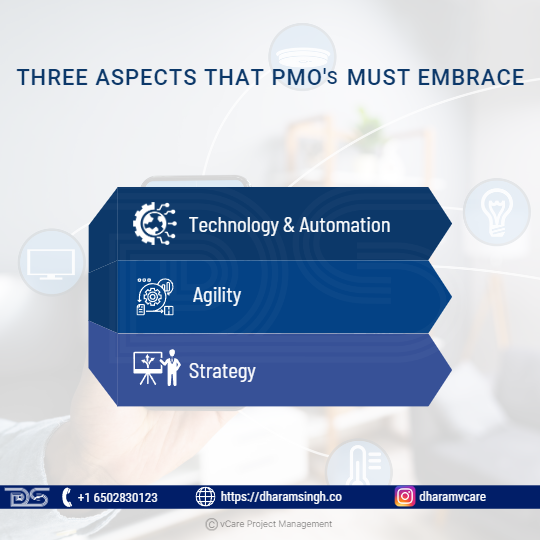
3 Aspects that PMOs must embrace
PMOs must also adjust to the new normal and growing business demands. The three areas described below represent the fundamental features that PMOs of the present and future must embrace to manage change effectively.
- Technology & Automation
Because Covid-19 has accelerated the way we utilize technology in our daily work, technology is expected to be front and center, enabling PMOs to deliver more successfully. To effectively adapt to new methods of working and build a “single source of truth,” advanced technologies and cloud-based solutions will be required. This technology jump is critical for borderless operations in which progress and transparent communication must be readily available and updated in real-time to allow for swift decision-making.
In the future world, both artificial intelligence and machine learning will be important facilitators of automating PMO procedures, delivering superior insights, and allowing teams to spend less time on manual transactional processing and more time generating value for projects. For example, project planning is often based on data collection, industry benchmarking, and using the experience of project managers. However, according to PMI – AI Innovators, there is still a significant inefficiency in project management, with around 1/3 of traditional project management activities requiring one or more days of manually collating reports. Using IoT and big data to automate various tedious processes allows the PMO to create more realistic and effective timetables and spot potential disruptors.
However, it is unlikely that technology will completely replace project managers, with the PMI forecasting that businesses will require over 88 million project managers by 2027. As a result, PMs will be expected to improve their competencies and fully utilize the available technologies.
PMOs will be required to lead by example in their automation projects, advocating new methods of working with their collaborative organization in the future. As a result, the paradigm of efficiently providing workstreams may evolve, driving firms to become more digital.
- Agility
With an increased level of complexity for transformation and multiple stakeholders to handle, projects may need to adapt and pivot in other ways than originally planned. Changes in priorities (39%) and objectives (37%) and the inability to adapt are the two leading reasons for project failure, according to PMI.
As a result, PMOs that can be responsive to change needs continually are critical to fulfilling project milestones, which might mean the difference between being an industry leader or a laggard. An agile PMO’s guiding principles are as follows:
- Decentralization of planning and decision-making
- Agile resource allocation and reallocation
- Workflows that are effective for continuous project advancement
An agile PMO may demonstrate agility by altering priorities and reallocating resources to achieve new objectives while transitioning seamlessly from reorganization to continuous delivery. Furthermore, decisions are decentralized, allowing faster response rates for recognizing and reducing hazards. Finally, communication is critical, with fewer layers of approval, and output is assessed by how much work can be done in a particular sprint.
However, merely establishing an agile PMO will only solve some difficulties; 47% of agile projects are late, have budget overruns, or result in dissatisfied consumers. A cultural revolution is required to fully realize agile’s potential, beginning with the leadership team and spreading across the firm.
As a result, the PMO cannot only act as an intermediary but also as a business partner, working alongside the leadership team and the rest of the organization. Team members must be self-sufficient, accountable, and have complete insight into project progress and data.
- Strategy
The PMO’s role must evolve from a team offering mere assurance to becoming a strategic partner with a vested interest in aligning with the organization’s ability to carry out its plan. As a result, the team is expected to have stronger strategic oversight of all work streams to deliver value throughout the project.
PMOs will be required to go beyond task completion and monitoring to include:
- Portfolio planning entails generating ideas for the activities required to capitalize on the opportunity.
- Project prioritizing entails determining the most effective timeframe and budgeting by the company’s demands.
- Capacity planning entails assigning the appropriate skills and resources to each work team.
- Resilience planning entails anticipating future obstacles and reducing interruptions.
- The strategic partnership is a cultural transformation in management and the PMO. The PMO is viewed as a business leader and adviser with a stake in the organization’s goals.
The key to success is consistent stakeholder engagement, with the PMO and business leaders holding frequent strategic discussions to monitor and coordinate company strategy and broad strategic objectives. This consistency will build a collaborative strategic management process and a fluid communication channel to adjust quickly and efficiently.
The future PMO will be more strategic and intricate in character than conventional models, emphasizing driving decision-making, execution, and outcomes while becoming more decentralized to interact with each workstream to achieve one common goal efficiently. Finally, PMOs will be more crucial than ever in addressing the complexities that organizations are now confronting. An effective transformation will need PMOs to serve as the organization’s voice and face.

Strategic project management office’s role in strategy execution
Strategic project management office’s role in strategy execution
Identifying, implementing, and managing strategic initiatives is critical to strategy execution. The strategies are implemented by creating strategic initiatives to support strategic objectives and fill gaps in strategic measures, and the value gap is bridged. Only projects that are connected with the strategic goal should be accepted.
When defining strategic initiatives/projects, the sequence of initiative execution is crucial since all related strategic initiatives must finish and provide value. The strategic initiatives cover almost all departments and corporate shared services. As governance becomes more important in project management, portfolios and programs are defined.
- Strategic initiatives are linked to similar programs and project execution.
- The projects will be managed by program managers, project managers, and another project team.
- Connecting programs and projects creates portfolios for portfolio managers and other project governance teams.
- Project, program, and portfolio definition is an iterative process reviewed multiple times to ensure interconnectivity and value generation.
Portfolio, program, and project management are critical components of strategy execution. Hence, everything is referred to as a Strategic Project Management Office (SPMO) or Enterprise Project Management Office (EPMO).
Final Thoughts
Organizations can only thrive in a highly competitive world if they innovate. Such innovation must occur at all levels of the organization, including goods, services, business processes, and business models.
The PMO has the authority to execute the innovation at all levels. Good project management regulates and fosters innovation through projects—customer satisfaction and profit growth when consistent outcomes are predictable. Project and program management practices establish the foundation for dependable plan execution. The efficacy of the organization’s initiatives and programs will influence corporate success when such practices are implemented throughout the organization.
The project management office (PMO) is a key change management component, working with other organizational structures, such as functional units, to improve project management competencies. However, in today’s competitive environment, businesses must rely on more than just solid strategies to secure success.
To succeed, managers must build organizations capable of attaining their strategic objectives faster than their competitors. This initiative involves the creation of organizations capable of performing today’s tasks more effectively while anticipating future disruptions. Successful execution of creative and strategic concepts leads to innovation. Competitive advantage is as much about execution as it is about strategy.
Feel free to check out my discussion on this topic with Justin Buckwalter in YouTube
For any questions related to your Project Management career, training, and certifications, you can book an obligation free 15 minutes session with me by visiting http://talktodharam.com/
You can subscribe to the vCare Project Management YouTube Channel to catch future videos of our Q&A series and certification success stories: https://bit.ly/2YF0wJl
You can subscribe to and follow my podcasts and interviews with Project Management Experts on YouTube at https://bit.ly/2NDY8wd

by DharamCW | Apr 21, 2023 | General
What makes a successful Project/Program/Portfolio Manager? Is it the number of years of experience? Technical know-how? Or the one who is good at managing people?
Creating objectives, critical path analysis, work breakdown structures, resource scheduling, and risk management are just a few of the technical areas of project management that project managers usually get training in. However, understanding pertinent people and management issues is important to a project’s success. In addition, a project manager must also continually deal with clients and other stakeholders. As a result, project managers’ people skills, also known as soft skills, are becoming increasingly important.
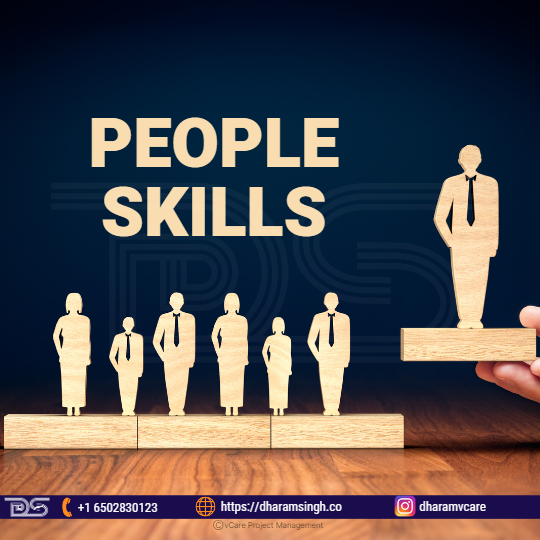
People Skills
People skills
People skills are linked with behavioral patterns or behavioral interactions that assist one in communicating effectively with people. Project leaders with strong people skills may favorably influence others, socialize effortlessly, and overcome public anxiety.
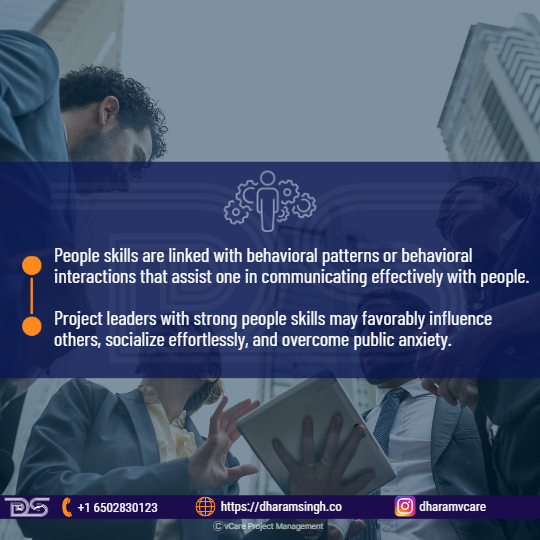
Project Leaders With Strong People Skills
They are transferrable social abilities that allow one to collaborate well with others. The three main types are personal, interaction, and interpersonal skills. These categories achieve the same overall objective: making the working connections with others mutually satisfying, pleasant, and productive.
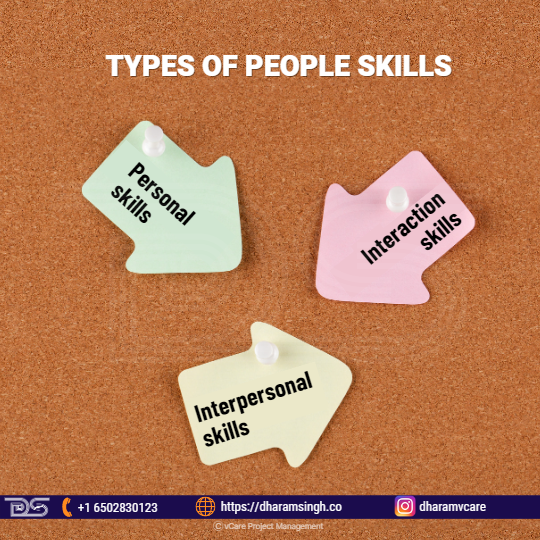
Types Of People Skills
Types of People Skills
- Personal skills: These include the capacity to communicate your skills and exhibit yourself to others successfully. It comprises characteristics such as self-assurance, honesty, and aggressiveness. Furthermore, one must be able to recognize their limitations and make sound judgments based on logic rather than emotion.
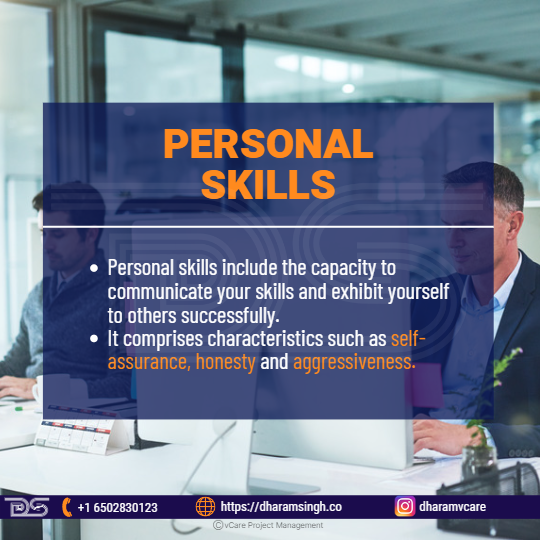
Personal Skills
- Interaction skills: It is essential for understanding the behavior and ideas of others while preserving limits and creating connections. A project manager, for example, should have social etiquettes that need empathy and listening skills to know that you have listened to them and given respect for their limits and requirements to connect with co-workers and clients productively.
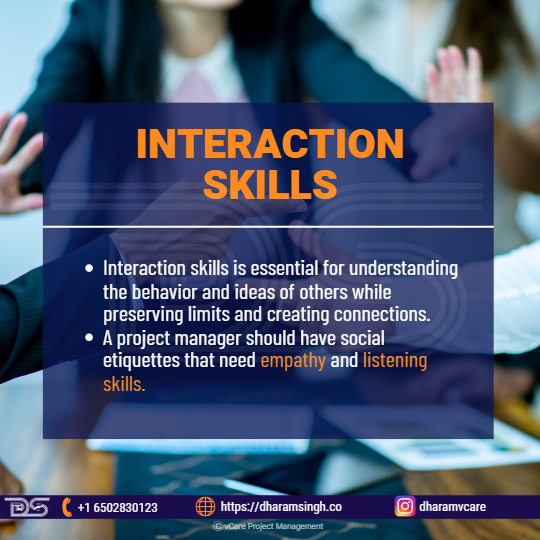
Interaction Skills
- Interpersonal skills: These are related to intercession skills, but they apply mainly to situations in which the persons involved have opposing interests or viewpoints.
Contrary to popular belief, people skills are not subjective concepts. On the contrary, these skills are critical, particularly in the project management role, which is largely concerned with people.
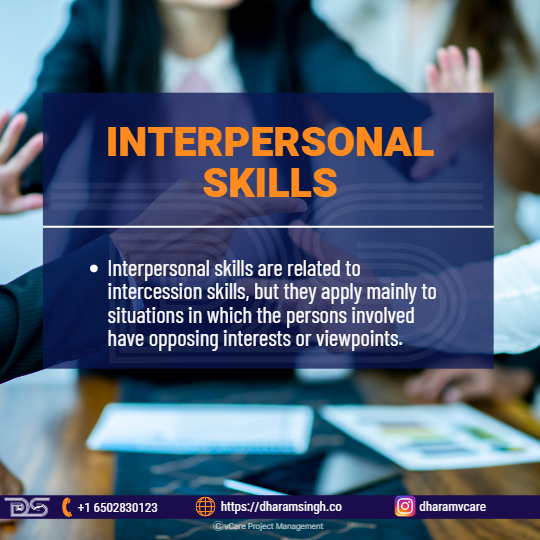
Interpersonal Skills
Project management is more than just completing the project; it is also about how you lead and assist your team. Leading others and leading them through the whole project lifecycle entails a certain amount of responsibility and necessitates certain abilities.
Furthermore, as work evolves, businesses embrace a varied workforce. As a result, people skills are essential for embracing tolerance and diversity. In short, good project management is based on human communication and connection.
Essential People Skills for Project/Program/Portfolio Managers
A successful project professional must possess a wide range of skills. Those that come to mind first are the technical skills required to create a project plan, schedule, budget, and all relevant paperwork. One must also have the conceptual skills to “see” the project as it develops.
However, such talents will only assure project success if the project manager can supplement their technical skills with a wide range of interpersonal skills or people skills. Here are some of the essential people skills for Project/Program/Portfolio Managers:
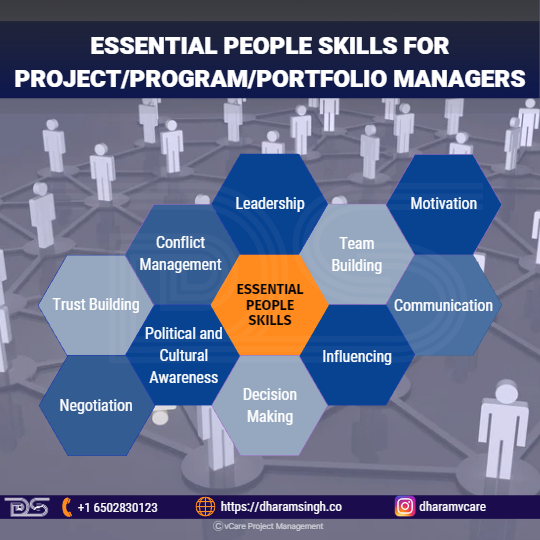
Essential People Skills for Project/Program/Portfolio Managers
- Leadership
One of the crucial skills a successful project manager has to have is leadership. This skill is essential because the project manager frequently has little control over the team members involved. This aspect calls for leadership on their part to handle the project. Although managing via leadership rather than authority might be more challenging, it is typically more effective since it is based on respect and trust.
At the start of a project, a leader must establish their vision and express it to the team. It makes supporting the project’s objectives easier for everyone on the team. Effective leadership will also keep the team members inspired and motivated to perform at their highest level.
- Team Building
Another vital skill for a competent project manager is team building. Because of the nature of projects, personnel from diverse departments are engaged. Most employees might have never worked together and may not even be familiar with one other’s departments. If the project manager can unite these individuals into a cohesive team with the same goal, the project may stay within its objectives.
Although some of the project’s individuals or sub-teams may execute their jobs individually, they must feel like they are part of the overall team. When choosing their part of the project, they must consider what is best for the project, not simply what is best for them and their departmental problem. A sense of belonging to a team that solves an issue for the entire company (rather than playing departmental favoritism) may go a long way.
Creating a team in which each member feels comfortable reaching out to the others will also guarantee that minor problems do not escalate into major concerns later in the project. It is consequently critical that project managers not only understand the duties and procedures involved in team building but also have the skill and finesse to apply them correctly.
- Motivation
If you want your project to succeed, you should concentrate on improving your motivating skills. Having these qualities will assist your project team members to stay interested in the project, strive for excellence, and work toward a common objective.
Good motivating skills will enable a project leader to create an environment where team members can fulfill project objectives while being satisfied with their work.
- Communication
Most professions require excellent communication skills. Some project managers believe the communication part of project management to be their primary job obligation.
Excellent communication skills are essential for building relationships among project team members, establishing trust, and keeping everyone motivated and on track.
A project involves several stakeholders informed of its status, timeframes, progress, risks, and concerns. A skilled project leader must convey all of these facts to project stakeholders on time and in the manner they anticipate. Project managers must also interact effectively with top management within their business.
Giving the interested stakeholders too much or not enough information might prevent the project from reaching its full potential.
- Influencing
It is critical to be able to influence people if you want to be a successful project manager. But what is important is understanding when and how to utilize such skills and avoid becoming a manipulator. There is a narrow path to follow.
A project manager’s responsibility is to bring employees from disparate departments together and get them to work together toward a similar objective. Sometimes, getting these diverse people to comprehend and agree on the specifics of achieving that goal might not be easy. A skilled project leader will utilize their skills to persuade others and assist them in reaching an agreement.
So, think about your relationship and influence over people not just for the time of the project but also for how things will proceed long after the project is complete. After the project, customers and end-users will utilize the goods, deliverables, and outcomes developed by the project. A powerful and positive effect creates a trusting atmosphere among all team members during and even after the project.
- Decision Making
A successful project manager must acquire various talents, one of which is decision-making skills. There are four primary decision-making styles: Directive, Analytical, Conceptual, and Behavioral. Project managers should be conversant with all four since either has to be leveraged at some time. In addition, consultation, consensus, command, and random styles are provided.
Having a decision-making model will facilitate this process. In addition, since so many people who may disagree with a decision are involved in the project, having a process to follow can be very helpful in gaining consensus with the group.
- Political and Cultural Awareness
In today’s world, project managers work in a more globalized context than in the past. As a result, cultural diversity is another critical component of effectively navigating the corporate world as a project leader. A successful project manager must be able to notice and comprehend cultural differences and incorporate them into the project plan.
Cultural differences can impact decision-making and the pace with which work is performed. It can also lead to members acting without sufficient forethought. Recognizing cultural differences can lead to conflict and stress within the project, further delaying it.
Furthermore, it is critical to understand the politics at work in the project environment. The use of political skills can greatly aid a project manager’s success. More significantly, failing to recognize the politics involved can lead to substantial challenges and impediments that can cause a project to be delayed or even destroyed.
- Negotiation
The nature of a project manager’s work necessitates being skilled negotiators. Typically, several stakeholders are involved in the project, and most projects include team members from many departments. This aspect frequently leads to a variety of points of view, which can make it challenging to keep the project on track and within the intended scope.
Negotiation skills can assist a project manager in obtaining an agreement or making a compromise on an issue that may be causing difficulty or delay.
There are several negotiation skills that the project leader should be able to employ. These include assessing each scenario, being an engaged listener, and communicating coherently throughout the dialogue. It can be important to distinguish between the wants and requirements of the people concerned. Another critical focus is recognizing the distinction between people’s perspectives and their interests and concerns directly relevant to the project.
- Trust Building
When collaborating on a project, trust is really valuable. A trusting environment promotes effective relationships and communication among team members and stakeholders. Therefore, a project leader wants to foster an atmosphere of mutual trust. This trust helps to maintain morale, keep conflict at a minimum, and keep everyone working effectively together.
If you were working on a project, you would want everyone participating and working hard to see it through to completion. When you work hard, you expect that others are also working hard to achieve the project objectives. The team leader wants to trust a team member who suggests they can execute a task properly and on time. If someone in the team wants assistance, they want a team that will support and collaborate to achieve the work. So don’t waste time second-guessing someone who isn’t telling the truth or has bad motives.
There are several approaches for a project manager to establish trust. First, a project leader must be a great and open communicator to reduce misunderstandings and build confidence among team members. Often, one may have to put their self-interests aside for the team’s sake and must model and display the behavior they demand from others.
- Conflict Management
On a project, conflict is almost unavoidable. Members of the project team and stakeholders may have differing perspectives, areas of expertise, interests, personalities, work styles, and so on. When one adds additional factors to the mix, such as tight deadlines, resource limits, and communication challenges, it’s easy to understand how conflict might arise.
Conflict often leads to a better solution to a problem. For example, if a team member would prefer to agree or accept the status quo, then risk causing conflict by pointing out a problem, asking a question, or suggesting an improvement. In that case, it is simpler to accept a suboptimal solution. However, disagreement frequently stops the team from working successfully together and diverts attention away from the duties at hand.
The goal is to prevent conflict or its escalation or to know how to regulate or lessen it when it arises if they cannot avoid it. For example, a project manager may use several tactics or methods when dealing with a dispute. They can be aggressive, accommodating, avoiding, or compromising. Some approaches work better in particular situations than others.
The project manager and team members involved in the conflict influence the team’s efficacy. A project manager can also utilize many approaches; if one fails, they may have to try another to see if it is more successful.
Why are people skills important?
People skills are crucial because it is much more difficult for people in an organization to work together to achieve common goals if they fail to express themselves or understand how their co-workers feel about a certain project, task, or difficulty.
As a result, the organization’s production and profitability suffer while creativity and innovation endure. People skills, in particular, may assist us in the following:
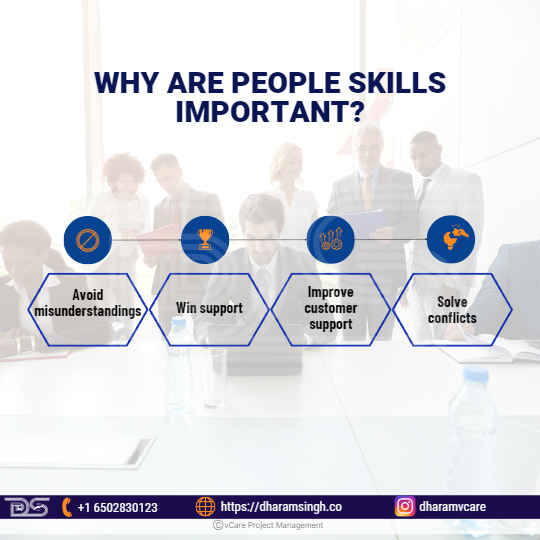
Why Are People Skills Important?
- Avoid misunderstandings: People are less likely to misinterpret what you’re saying if you communicate ideas and instructions.
- Win support: If you can communicate effectively and understand what your team wants to hear, it will be much simpler to persuade them and get them “on board.”
- Improve customer support: You’ll be better positioned to fix their difficulties if you can get inside their minds and comprehend their key problems.
- Solve conflicts: Conflict isn’t always unpleasant, but if it goes unresolved, it can harm morale and productivity. Strong people skills allow us to see things from a new perspective and identify similarities, which reduces the likelihood of significant conflicts.
How to develop people skills?
Even while people skills are critical, they are frequently undervalued by employers when it comes to job advancement. Internal training sessions are frequently centered on teaching hard skills, such as completing a given activity or utilizing a specific piece of software. These methods make it more difficult for professionals to build their interpersonal skills.
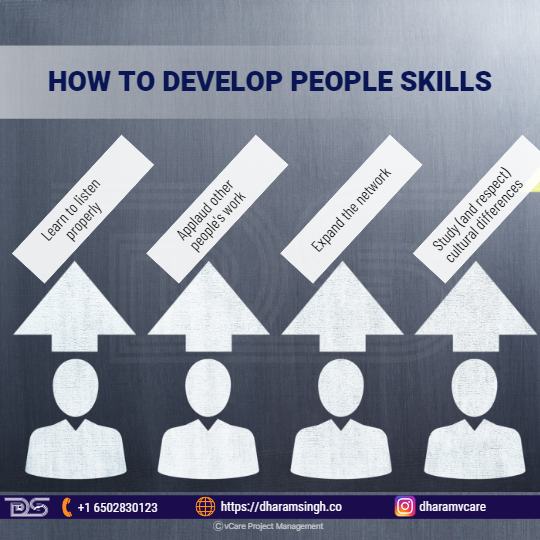
How To Develop People Skills?
But just because something is more difficult does not make it impossible. Here are four suggestions for improving people skills and becoming a more attractive prospect are:
- Learn to listen properly
- Applaud other people’s work
- Expand the network
- Study (and respect) cultural differences
Final Thoughts
Effective project management is challenging but having people skills may help project leaders run projects more efficiently and with less stress. Furthermore, it enables building a team that can handle the most challenging tasks and is more successful and resilient during difficult times.
People skills, on their own, will not keep a project team motivated and engaged. However, arming oneself with the necessary technical skills and intelligent tools may dramatically enhance the workflow and contribute to the project’s success.
Feel free to check out my discussion on this topic with Thomas Walenta in YouTube
For any questions related to your Project Management career, training, and certifications, you can book an obligation free 15 minutes session with me by visiting http://talktodharam.com/
You can subscribe to the vCare Project Management YouTube Channel to catch future videos of our Q&A series and certification success stories: https://bit.ly/2YF0wJl
You can subscribe to and follow my podcasts and interviews with Project Management Experts on YouTube at https://bit.ly/2NDY8wd
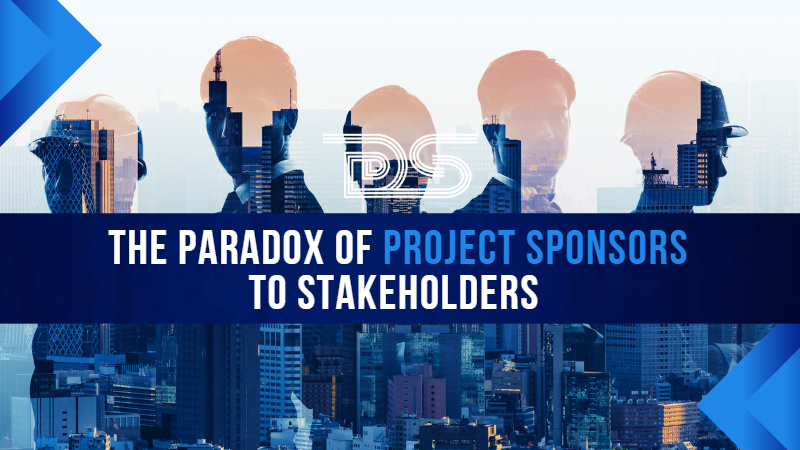
by DharamCW | Mar 10, 2023 | General
A project is deemed successful when it meets or exceeds the expectations of its stakeholders. Every project has a unique set of stakeholders—sometimes far too many. Trying to meet all of their requirements is more often an impossible task. Nonetheless, the project manager must deal with all stakeholder situations smoothly because the stakeholders and the people they represent often evaluate the project’s success.
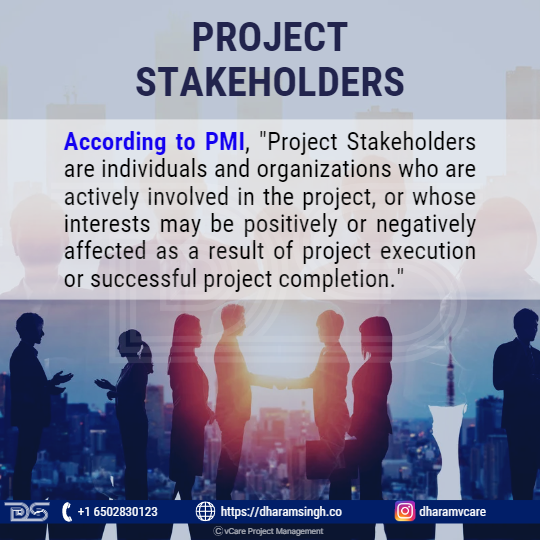
Project Stakeholders
But who are the stakeholders? According to PMI, “Project stakeholders are individuals and organizations who are actively involved in the project, or whose interests may be positively or negatively affected as a result of project execution or successful project completion.”
Stakeholders can be internal or external to the organization that is carrying out the project.
“Project Sponsor” is also a stakeholder, typically an organization executive with authority to assign resources and enforce project decisions. Project sponsors are called internal stakeholders in the project. Stakeholders include the project manager, project team members, and managers from other departments within the organization. Identifying all project stakeholders as early as possible in a project is critical. Leaving out key stakeholders or the department’s function and not discovering the fault until the project is well underway could be disastrous.
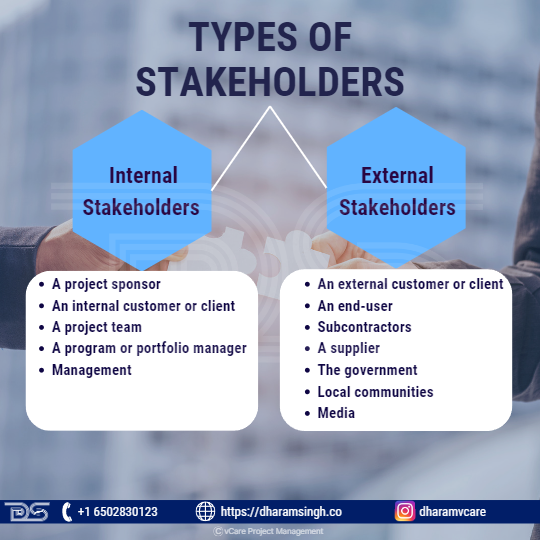
Types of Stakeholders
Types of Stakeholders
There are two types of project stakeholders:
- Internal Stakeholders
- External Stakeholders
Internal stakeholders are individuals or businesses whose relationship with a company is determined by their position within its structure. As the name implies, these individuals are involved in a project from the inside. They are as follows:
- A project sponsor
- An internal customer or client
- A project team
- A program or portfolio manager
- Management
- Another team’s manager of the company
External stakeholders are those interested in a company’s operations. Still, they do not necessarily have a role in the decisions of the business. However, they can influence success or failure based on their vested interests. They can be just as powerful as internal stakeholders. These stakeholders are not directly involved in the project but are affected by its outcome.
- An external customer or client
- An end-user
- Subcontractors
- A supplier
- The government
- Local communities
- Media
Characteristics of Stakeholders in a Project
- When contributing to a project, stakeholders have varying levels of responsibility and authority. This level may change as the project progresses. It can range from one-time contributions to complete project sponsorship.
- Some stakeholders may also actively or passively undermine the project’s success. These stakeholders require the project manager’s attention throughout the project’s life cycle.
- Stakeholder identification is a continuous process throughout the project’s life cycle. Identifying them, understanding their level of impact on a project, and meeting their demands, needs, and expectations are critical to the project’s success.
- Just as they can positively or negatively impact a project’s objectives, stakeholders can perceive a project to have positive or negative outcomes.
- A project manager’s most important role is managing stakeholder expectations, which can be challenging because stakeholders often have different or conflicting goals.
Stakeholder Management
Stakeholder management is the process of organizing, monitoring, and improving relationships with stakeholders. It entails systematically identifying stakeholders, analyzing their needs and expectations, and planning and carrying out various tasks to engage them. In addition, a good stakeholder management process will allow them to coordinate their interactions and evaluate the status and quality of their relationships with various stakeholders.
A critical component of running a successful project is developing and maintaining positive relationships with the affected communities and other stakeholders.
Investing time in identifying and prioritizing stakeholders, as well as assessing their interests, provides a solid foundation on which to build the stakeholder engagement strategy. In addition, good stakeholder management includes ‘business intelligence.
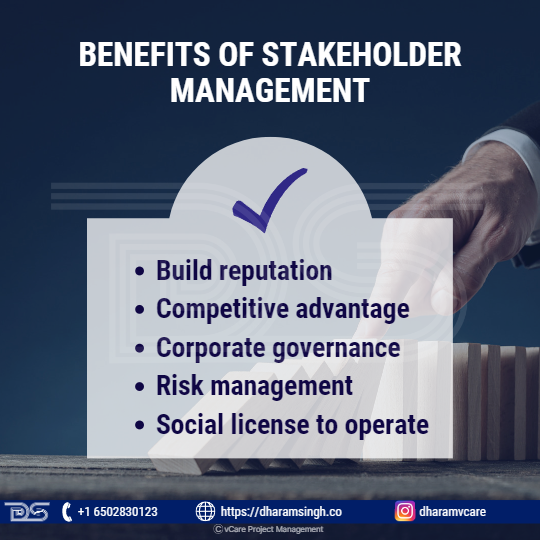
Benefits of Stakeholder Management
Benefits of Stakeholder Management
- Build Reputation
- Competitive advantage
- Corporate governance
- Risk management
- Social license to operate
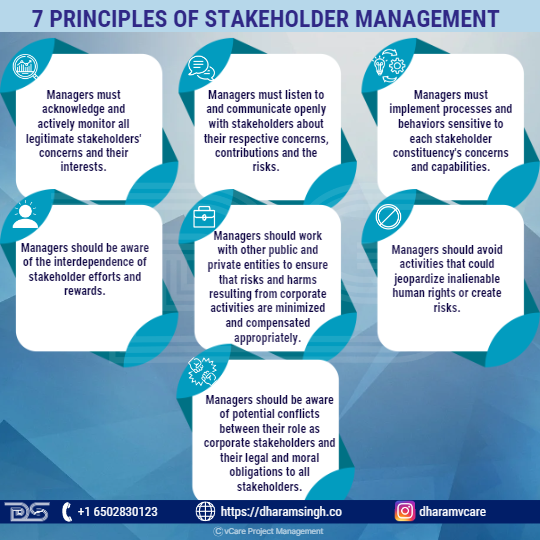
7 Principles of Stakeholder Management
7 Principles of Stakeholder Management
Clarkson Centre created the seven principles of Stakeholder Management for Business Ethics under the leadership of Max Clarkson. The Clarkson Principles are, in many ways, “meta-principles” that encourage management to embrace specific stakeholder principles and implement them according to the norms.
- Managers must acknowledge and actively monitor all legitimate stakeholders’ concerns and consider their interests in decision-making and operations.
- Managers must listen to and communicate openly with stakeholders about their respective concerns and contributions and the risks they face from their involvement with the corporation.
- Managers must implement processes and behaviors sensitive to each stakeholder constituency’s concerns and capabilities.
- Managers should be aware of the interdependence of stakeholder efforts and rewards and make an effort to fairly distribute the costs and benefits of corporate activity among them while taking into account their risks and vulnerabilities.
- Managers should work with other public and private entities to ensure that risks and harms resulting from corporate activities are minimized and compensated appropriately where they cannot be avoided.
- Managers should avoid activities that could jeopardize inalienable human rights or create risks that, if clearly understood, would be patently unacceptable to relevant stakeholders.
- Managers should be aware of potential conflicts between their role as corporate stakeholders and their legal and moral obligations to all stakeholders and address such conflicts through open communication, appropriate reporting and incentive systems, and, if necessary, third-party review.
Understanding the Stakeholders
A good understanding of the stakeholders is the key to successful stakeholder engagement. In addition, understanding stakeholder concerns and interests can lead to product or service ideas that address stakeholder needs while allowing the company to cut costs and maximize value.
1. What else can you learn about stakeholders to better understand their needs, priorities, preferences, and concerns? Consider:
- Demographic data- Ensure to engage with a diverse community and stakeholder groups.
- Social networks- Focus on the important, often undocumented, social connections between stakeholders.
2. Stakeholder Mapping – Stakeholder mapping is the visual process of depicting all stakeholders of a product, project, or idea on a single map. The main advantage of a stakeholder map is that it provides a visual representation of all the people who can have an impact on your project and how they are connected.
3. Salience model – investigate the power, urgency (need for immediate action), and legitimacy (appropriate stakeholders), as well as the interaction or groups of stakeholders that result.
4. Determine stakeholder expectations and compare them to the scope and expectations of the project or organization for which the engagement program is being run. Is there a mismatch in expectations, and how will this be addressed? Consider the following:
- What information do they need from you, how often, and in what format/channel do they want it?
- What is their financial/social/emotional stake in the outcome of the work? Is it favorable or unfavorable?
- What primary motivations will shape their perceptions of your project or organization and their interactions with you?
- What are their current feelings about the organization and project? Is it founded on reliable data?
- Who influences their thoughts, and who are they influenced by?
Ways to deal with common stakeholder problems and challenges
- Stakeholder conflict occurs when different stakeholders have incompatible goals. It causes a “problem” for the company because it can impact its performance and success.
- Conflict necessitates that businesses effectively manage stakeholder interests. Not all stakeholders are strategically important to the company. As a result, businesses must determine which ones should be prioritized.
- Potential problems can be avoided by conducting an upfront analysis of who the stakeholders are and how and when to involve them in the project.
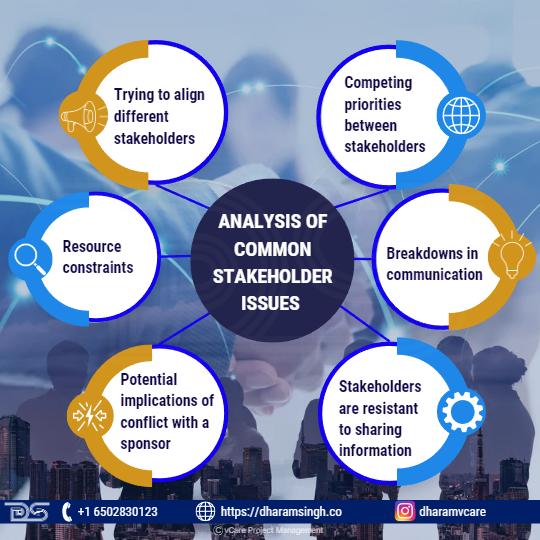
Analysis of common stakeholder issues
Analysis of common stakeholder issues
As no two stakeholders are the same, the issues they may introduce into a project will be vastly different. This factor means there could be many reasons why a project encounters stakeholder resistance or the project team struggles to gain traction. Identifying stakeholder issues during the project can help with planning ahead of time and preparing an appropriate response.
- Trying to align different stakeholders.
It is generally a good thing to have a variety of interests in the project and its outcome, but having a lot of different stakeholders can also pull the project team in too many different directions. In addition, it can be challenging for project managers to coordinate too many different stakeholders, which could add new difficulties to the project.
- Competing priorities between stakeholders
Stakeholders bring their objectives and expectations to the project. However, at least a few of these priorities frequently conflict with or compete with one another. In addition, priorities may vary depending on the department, the role, or the professional backgrounds of the individuals.
- Resource constraints
It’s possible that the team lacks some of the resources they require or that the project is utilizing resources that other stakeholders consider crucial to their projects. Resource competition is common in organizations and can lead to conflict.
- Breakdowns in communication
Effective communication between stakeholders and the project team is crucial for everyone to achieve their objectives and for the project to be successful. When there are communication breakdowns, the project may be delayed, or the team may not receive the necessary information. Without deliberate communication, stakeholders might unintentionally hinder the project’s success.
- Stakeholders are resistant to sharing information.
At times, important project sponsors are more focused on their success and fail to promptly or completely provide the stakeholders with the required information. As a result, stakeholders may attempt to disrupt a project unintentionally or on purpose.
- Potential implications of conflict with a sponsor
Conflict with project sponsors may have many consequences on the project management, such as these typical ones:
- The project’s progress is being slowed
- Reducing the effectiveness and timeliness of decision-making
- Putting team cohesion in jeopardy
- Undermining a project manager’s authority
- Fostering hostility and encouraging uncooperative behavior
- Creating a fearful environment for other stakeholders
- Obscuring the project’s vision
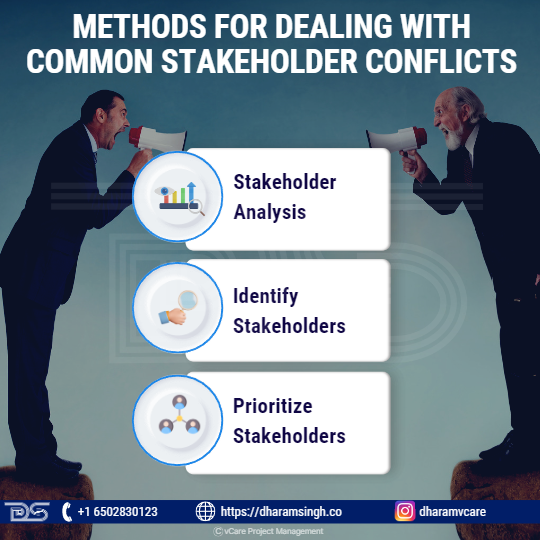
Methods for dealing with common stakeholder conflicts
Methods for dealing with common stakeholder conflicts
- Stakeholder analysis
Stakeholder analysis can offer insightful information and guidance, just as project managers must carefully examine resources and specifics. It can be helpful to respond appropriately by taking the time to consider how stakeholders affect the project’s progress.
By conducting a stakeholder analysis, one can learn how to control expectations, channel stakeholder influence toward project objectives, and deliver the information and updates that stakeholders expect from their team.
- Identify stakeholders
One must first identify the stakeholders to analyze them effectively. List every stakeholder that comes to mind, then include more individuals and organizations as necessary. As stakeholders, all parties involved in the project, those with authority over it or an interest in its success, should be listed.
- Prioritize stakeholders
The list of stakeholders can then be ranked according to impact, interest, and power. For instance:
- Key stakeholders: This first group heavily influences and controls the project. This group is frequently accurate for executive leadership at the company.
- Primary stakeholders: The project immediately affects the key stakeholders. This pack may include team members, departments, and internal or external clients who stand to gain from the project’s outcomes.
- Secondary stakeholders: The secondary stakeholders are those who play a supporting role, are indirectly impacted or have a less significant stake in the project.
Understand the key stakeholders
A few stakeholders are usually critical to the project. Key stakeholders invoke more power and may have a more significant stake in the project’s success than primary or secondary stakeholders. For example, key stakeholders could include their boss, company executives, or team leaders.
Finding the key stakeholders and understanding what they need can help keep the project on track because they may control important resources, have a significant impact on the project, or grant the necessary approval.
Create a communication plan
With a communication plan, project leaders will be better prepared to manage their stakeholders on the fly and keep the project moving forward.
- Create your communication strategy based on what the project leader knows about their stakeholders.
- Keeping track of what the stakeholders require from themselves allows project leaders to stay organized and focused on managing the project.
- Gaining the stakeholders’ trust is essential once the developed strategy has been implemented. Rather than dictating the project to them, make each stakeholder a priority – as appropriate – and give them space to contribute.
Final Thoughts
Different stakeholders in the project have different expectations. Project managers should look for potentially hazardous situations when those expectations might clash. Then, they must address and resolve the conflict or risk endangering the project and themselves.
Resolving stakeholder expectations conflicts is always linked to project success. Furthermore, using various forms of communication among the project team, such as senior management and stakeholders, increases the likelihood of mutual understanding. These techniques help project managers align stakeholder expectations and reduce the possibility of project distress.
Feel free to check out my discussion on this topic with Thomas Walenta in YouTube
For any questions related to your Project Management career, training, and certifications, you can book an obligation free 15 minutes session with me by visiting http://talktodharam.com/
You can subscribe to the vCare Project Management YouTube Channel to catch future videos of our Q&A series and certification success stories: https://bit.ly/2YF0wJl
You can subscribe to and follow my podcasts and interviews with Project Management Experts on YouTube at https://bit.ly/2NDY8wd
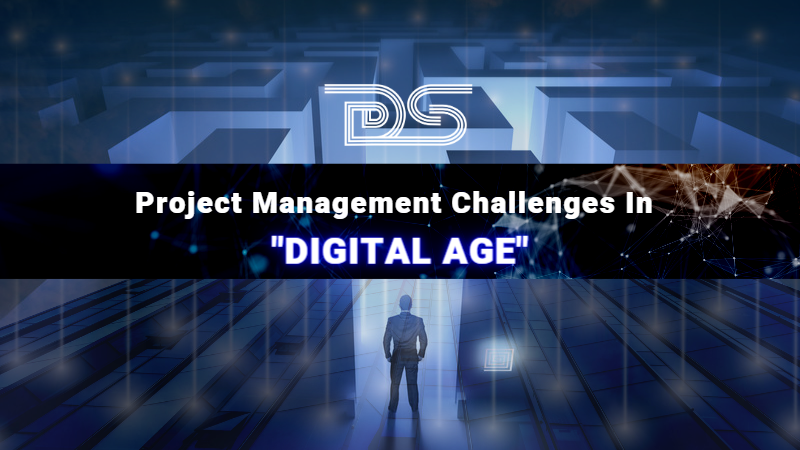
by DharamCW | Dec 18, 2022 | General
Artificial Intelligence, the most common and vibrant technical term in the 21st century, has begun to rule the world stage with its intelligent functionalities. There is no doubt that AI is transforming the productivity and workflow of various industries around the world. However, there may be a constant concern about human job opportunities in the coming years. Organizations have gradually realized that Artificial Intelligence requires collaboration with human employees, and ample job opportunities are emerging.
Impacts of Artificial Intelligence on Project Management
Project management has evolved significantly in the last decades. According to an IPMA & PwC report, 56% of organizations has already digital transformation projects, including AI adoption. The current adoption of AI among project professionals is expected to move from 27% to 35% in the next three years.
The organization must consider that successfully implementing projects in the digital age necessitates new skills and different focus areas for project managers. There is a growing demand for digital literacy, critical thinking, and creativity skills, replacing traditional project management skills such as teamwork, communication, and the ability to build effective relationships.
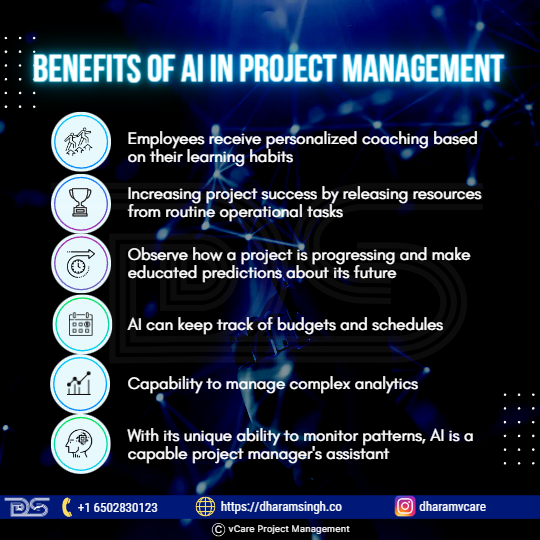
Benefits of AI in Project Management
Benefits of AI in Project Management
Aggregating task statuses to generate weekly status reports, calculating the budget implications of increasing scope and timeline, and performing risk modeling are all functions that an AI technique in your project management software can provide. Here are a few more advantages of AI-enhanced project management:
- Employees receive personalized coaching based on their learning habits.
- Increasing project success by releasing resources from routine operational tasks.
- Observe how a project is progressing and make educated predictions about its future.
- AI can keep track of budgets and schedules.
- Capability to manage complex analytics.
- With its unique ability to monitor patterns, AI is a capable project manager’s assistant.
Digital Skills for Project Managers
Businesses are creating better products and stronger customer relationships at an unprecedented rate. They rely on a workforce with the necessary skills and experience to deal with the effects of disruptive technologies. Organizations combine those experts with data and digital tools such as artificial intelligence and machine learning that allow for agility and speed.
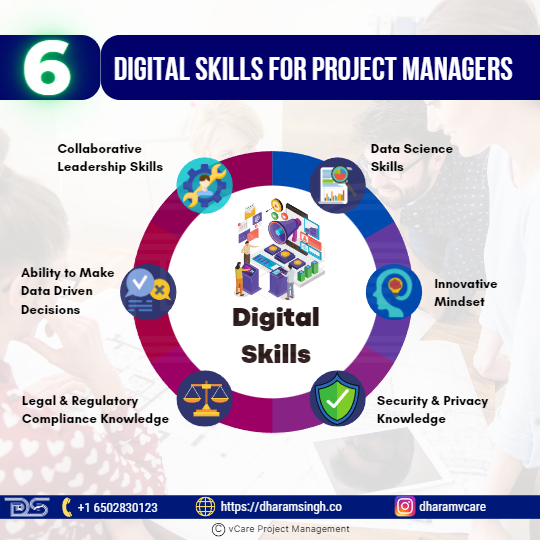
Digital Skills for Project Managers
Top Six digital-age skills for Project Delivery
1. Data Science Skills
Data science is the umbrella term for data management, analytics, and big data. It focuses on Project Managers’ ability to extract meaningful knowledge from available data to improve project outcomes. Data science is expected to play an increasingly important role in all stages of project development, from planning to completion.
2. Innovative Mindset
Today’s project teams are being asked to do more with less. That means that Project Managers who can think creatively and find new ways to achieve great results will be in high demand in the job market. Skills and experience are no longer sufficient. It is now critical to provide examples of one innovative mindset in the workplace.
3. Security and Privacy Knowledge
Today, most businesses and individuals are concerned about data security. In addition to the legal requirements, there is a general expectation that all personal and project data is handled securely. This skill is becoming increasingly important as more projects rely on digital information systems.
The best Project Managers contribute to the security of the projects they manage. They are aware of the requirements and collaborate closely with their IT and legal teams to ensure that data security guidelines are incorporated into each step of project delivery.
4. Legal and Regulatory Compliance Knowledge
Ensuring the project is legal and regulatory compliant is not new. Leading Project Managers are always aware of this. The difference that the digital age brings is the growing need to act as a bridge between project teams and the IT, Legal, and Data Protection teams, all of which are critical to the process but need little understanding of each other’s areas of expertise.
5. Ability to Make Data Driven Decisions
Using data to make sound business decisions is core to the best practice of project management. Today’s challenge is synthesizing the massive amount of data available to gain useful insights that propel a project forward. Data is only useful if it is appropriately interpreted. The best project managers use cutting-edge tools to make informed decisions and gain an advantage.
6. Collaborative Leadership Skills
Because of remote working, outsourcing, and cross-functional teams spread across multiple locations, Project Managers today require collaborative solid leadership skills more than ever. Their ability to establish standards and bring team members together (even if only virtually) for the sake of the project is becoming increasingly important. Project managers who can implement collaborative platforms and work management tools to improve their team’s work will outperform their competitors.
An Emotionally Intelligent Project Manager
Emotional intelligence can be referred to as our ability to recognize, control, and communicate emotions. People with high emotional intelligence understand how they feel, what their feelings imply, and how their feelings affect others. In interpersonal situations, it is also the ability to empathize with others. Emotional intelligence is about creating a positive work environment, which is critical to the success of any project.
According to a LiquidPlanner study, most project managers commit approximately 10% of their time to people-related activities. Top project managers dedicate 70% of their time to these activities. As a result, emotional intelligence is critical to project success.
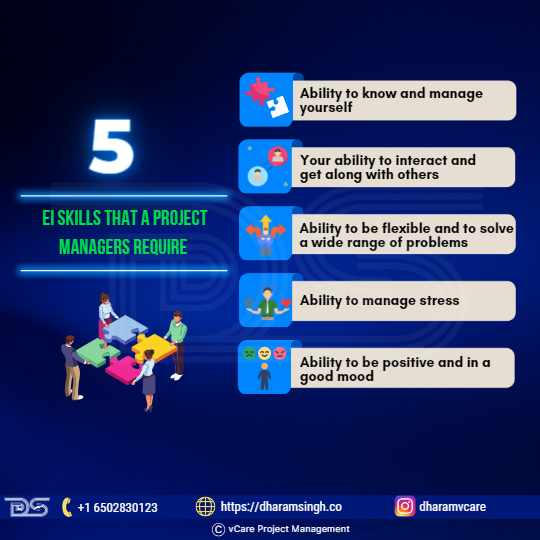
EI skills that a Project Managers require
Some EI skills that project managers require are:
- Intra – Personal – Ability to know and manage yourself
- Inter–Personal – Your ability to interact and get along with others
- Adaptability – Ability to be flexible and to solve a wide range of problems
- Stress Management – – Ability to manage stress
- General Mood – Ability to be positive and in a good mood
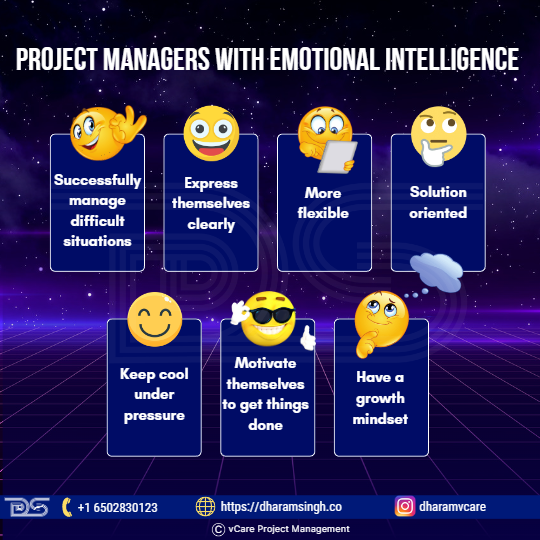
Project Managers with Emotional Intelligence
Emotionally Intelligent Project Managers
Project managers with high emotional intelligence have a better chance of success, better physical and mental health, good work relationships, and lower stress levels. Project managers with emotional intelligence can also:
- Successfully manage difficult situations
- Express themselves clearly
- More flexible
- Solution-oriented
- Keep cool under pressure
- Motivate themselves to get things done
- Have a growth mindset
Project Leadership in “DIGITAL AGE”
Over the last decade, the project management practice has evolved from a simple guide for project managers to a deeper understanding of organizational maturity and business agility. However, to capture the true essence of organizational maturity and business agility, the project management practice needed to evolve again, this time by adapting to the needs of the digital world.
According to a PMI’s report, The Project Manager of the Future, which surveyed over 450 HR professionals, over three-quarters of these organizations recognized the importance of project managers understanding disruptive technologies. They were actively recruiting project professionals with specialized skill sets required to manage the impact of disruptive technologies. But what are these skill sets?
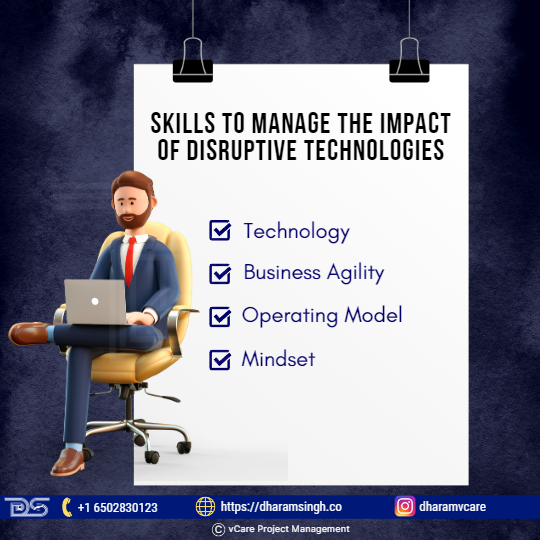
Skills to manage the impact of disruptive technologies
- Technology
- Mindset
- Operating Model
- Business Agility
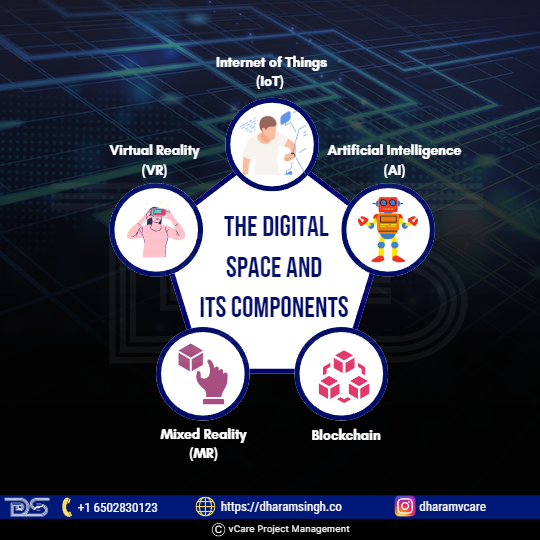
The Digital Space and its Components
Beyond using digital transformation as a token, project managers must gain a thorough understanding of the digital space and its various components, such as the Internet of Things (IoT), Artificial Intelligence (AI), Blockchain, Virtual Reality (VR), and Mixed Reality (MR).
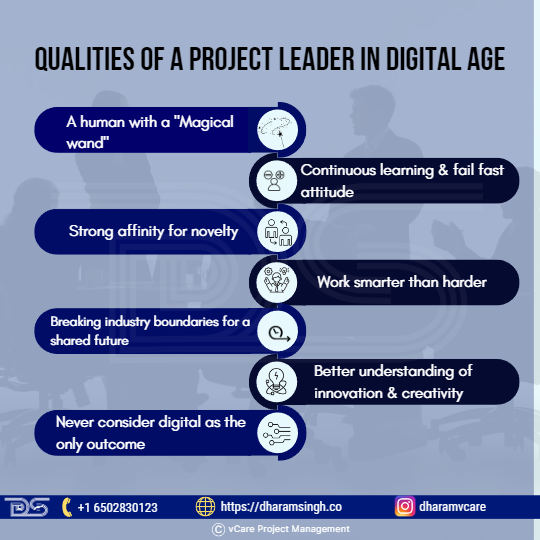
Qualities of a Project Leader in Digital Age
Along with that, the project leader must have these qualities in the digital age:
- A human with a “Magical wand”
- Continuous learning & fail fast attitude
- Strong affinity for novelty
- Work smarter than harder
- Breaking industry boundaries for a shared future
- Better Understanding of Innovation & Creativity
- Never consider digital as the only outcome
Digital transformation in project management is more of a collective mindset than a task that can be checked off as completed. It describes a vision that needs constant improvement and encourages future innovation and growth.
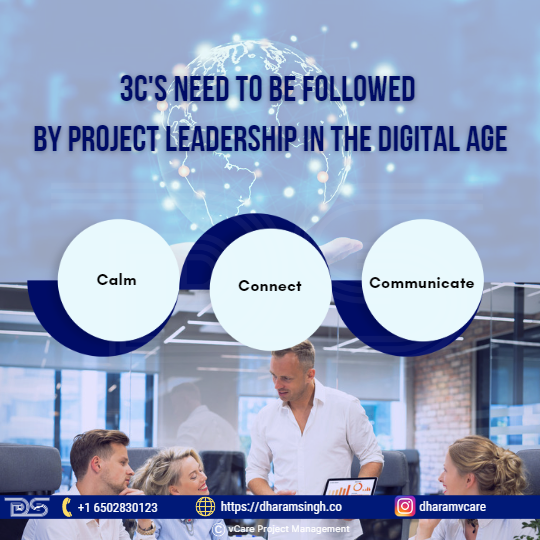
3C’s need to be followed by project leadership in the digital age
Here are the 3C’s need to be followed by project leadership in the digital age:
- Calm – Inspire more trust and better performance.
- Connect – People will forget what you said, People will forget what you did, and People will never forget how you made them feel that moment.
- Communicate – The biggest problem in communication is the illusion that it has occurred.
Challenges faced by Project leadership Teams
1. Disconnected & disengaged remote workforce
HR leaders and project managers nowadays, regardless of industry or size of business, assume that connecting with people within the organization is becoming increasingly difficult. Remote working, prompted by the pandemic, has only exacerbated the situation. But why is having a connected workforce important?
A well-connected workforce means employees and the company’s vision, mission, and values are connected. Employees who might feel isolated and disconnected from the business and its goals and objectives, regardless of where they work, are likely to feel disengaged and demotivated, which may affect productivity and efficiency at work. Here are some ideas for how businesses can manage disengagement and create a more connected workforce.
- Use technology to stay connected
- Recognize the good work
- Implement Open Culture
2. Uncertainty in decision making
Project managers strive to conform to all elements and avoid uncertainty in project management to ensure the success of their endeavor. However, no one can predict the future. Working on large, complex projects, such as those in technology, frequently entails high uncertainty in terms of time, cost, and scope, as well as uncontrollable external forces such as inflation, regulation, and financing constraints. These factors can impact a project management system’s ability to assist managers in leading and monitoring projects. Therefore, the project management must comprehend the process of applying decision analysis techniques to the practice of project management, like:
- A process that can assist project managers in improving their ability to make decisions under uncertain conditions.
- A process that can assist project managers in confronting
- Resolving the realities of the project management—uncertainty, external influences, and risk.
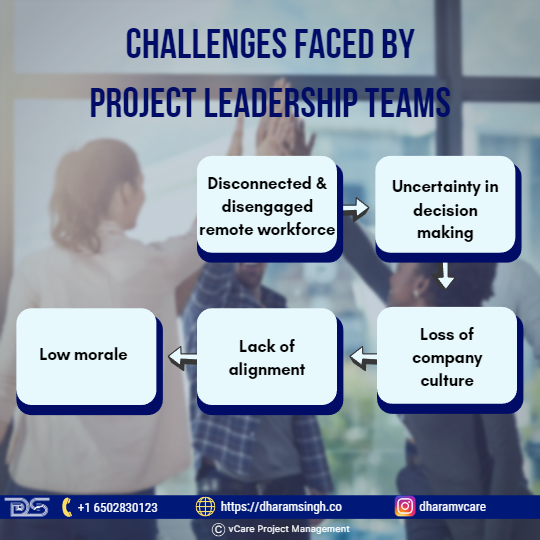
Challenges faced by Project Leadership Teams
3. Loss of company culture
Employee attitudes, values, beliefs, behaviors, and underlying assumptions comprise organizational culture. Furthermore, culture is important because it forms the foundation of the business logic applied to any specific decision or problem; there is a minimal chance that something will be done that violates the culture because it would mean contradicting fundamental beliefs.
An organization’s culture, which is not supportive of project management, may be perceived as an additional burden and an impediment to daily work.
4. Lack of alignment
Project success begins with good project management practices and a good team. But how do you make sure they’re in sync? Especially when alignment requirements can take many forms, such as alignment to the overall strategy, stakeholder expectations, mandated processes or policy, or delivering the right things at the right time and in the right way.
Moreover, business organizations may require precise alignment of project strategy to prevent projects from duplicating work or producing useless deliverables to reduce waste and manage costs. Strategic thinking is one way to foster the game-changing power of aligned organizational strategy to project outcomes.
5. Low morale
Employee morale is employees’ attitude, contentment, loyalty, and willingness to give their all and actively contribute to their employer’s success. It’s also about how they feel about their job and workplace.
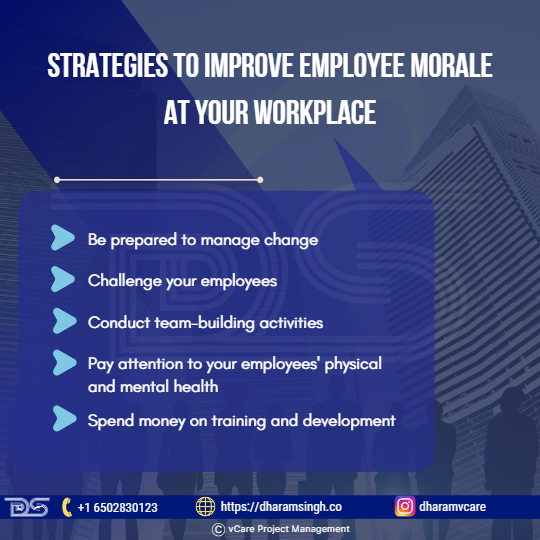
Strategies to improve Employee Morale at your workplace
If the employee morale is low, it may reduce motivation and efficiency. Employees with low morale produce only the bare minimum of work. As a capable leader, improving workplace morale should be one of your top priorities. According to an SHRM survey, 67 percent of employers find it challenging to maintain employee morale. However, the good news is that the following strategies can help immediately improve employee morale at your workplace.
- Be prepared to manage change
- Challenge your employees
- Conduct team-building activities
- Pay attention to your employees’ physical and mental health
- Spend money on training and development
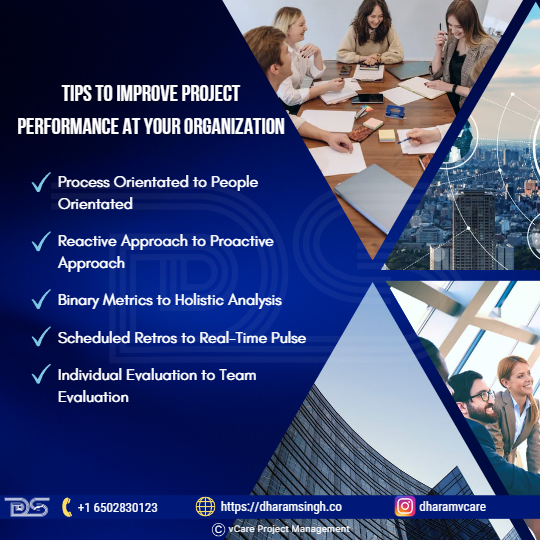
Tips to improve project performance at your organization
Revamp Project Team Performance
A combination of managerial skills and software tools are used to improve project performance. Ensure that the team understands the goal of every project, has access to open communication channels, and understands the importance of tasks. In addition, project management software can create consistent project plans and automate time tracking and billing to improve project performance. Here are some tips to improve project performance at your organization.
- Process Orientated to People Orientated
- Reactive Approach to Proactive Approach
- Binary Metrics to Holistic Analysis
- Scheduled Retros to Real-Time Pulse
- Individual Evaluation to Team Evaluation
The Five Dysfunctions of a Team
Patrick Lencioni, the author of “The Five Dysfunctions of a Team” examines why effective teams are so rare and offer specific recommendations for removing barriers that lead to dysfunctional teams. The work of Lencioni outlines the causes of team dysfunction and what can be done to overcome each one.
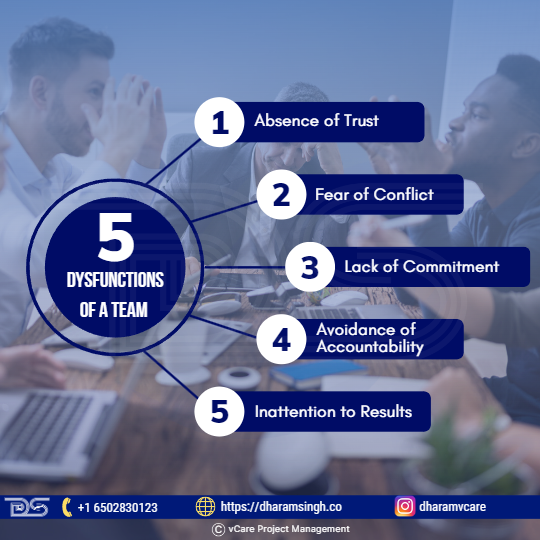
5 Dysfunctions of a Team
The five dysfunctions which have been compared with project management are:
- Absence of Trust – Teams that lack trust conceals flaws and mistakes, are hesitant to seek assistance, make assumptions about the intentions of others, harbor grudges, and dread meetings.
- Fear of Conflict – Fear of conflict results from a lack of trust. Most companies’ employees are more concerned with politics and personal risk management than problem-solving. As a result, meetings are frequently boring because contentious issues are avoided.
- Lack of Commitment – When teams avoid conflict, they fear failure. These teams struggle to make decisions and constantly second-guess themselves.
- Avoidance of Accountability – Second-guessing and a lack of common objectives lead to an inability to develop performance standards. Team members miss deadlines and produce mediocre results.
- Inattention to results – When teams lack focus and clear objectives, team members become stagnant, distracted, and self-centered.
High-performance teams
High-performance work teams are critical to how most organizations perform and carry out their work, resulting in superior performance and a significant competitive advantage. A high-performance team also requires the following to function effectively:
- Uplift the quality of work.
- Mentor guidance to increase productivity.
- Peer-to-Peer monitoring & building a competitive environment.
- Facilitating & enriching the team to handle emerging project delivery practices.
Nurturing the Right Culture
Building an organization’s strong project management culture opens the door to numerous benefits and improves customer service. Organizations with solid project cultures operate under a unique value system that aligns each team member with objectives and goals on a budget, time, and target. Professionals today are expected to demonstrate a wide range of skills and juggle multiple organizational tasks.
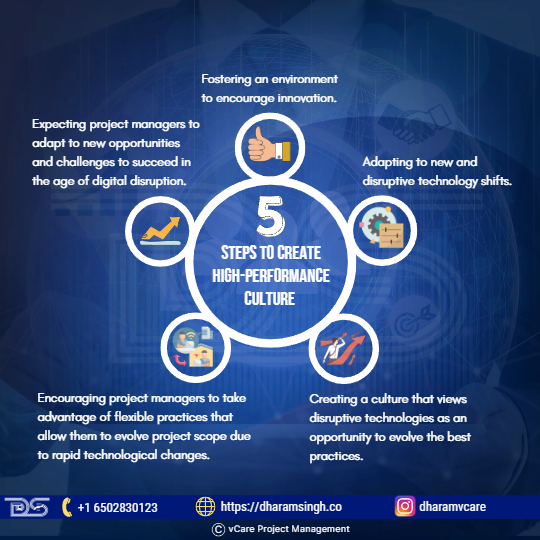
Steps to create High-Performance Culture
5 Steps Involved in Creating High-Performance Culture
- Fostering an environment to encourage innovation.
- Adapting to new and disruptive technology shifts.
- Creating a culture that views disruptive technologies as an opportunity to evolve the best practices.
- Encouraging project managers to take advantage of flexible practices that allow them to evolve project scope/requirements due to rapid technological changes.
- Expecting project managers to adapt to new opportunities and challenges to succeed in the age of digital disruption.
Conclusion
To capitalize on all opportunities created by technological disruption, the most forward-thinking organizations rely on the power of project leaders. One significant competitive advantage is where project leaders are prepared, willing, and able to assist their organizations in surviving and truly thriving in the face of massive change.
However, innovative organizations recognize that project leaders with the necessary digital-era skill sets do not appear by chance. As a result, innovators understand the importance of investing in three key areas:
- Skills, training, and development
- Tools and approaches
- Culture
Feel free to check out my discussion on this topic with Thomas Walenta in YouTube
You can subscribe and follow my podcasts and interviews with Project Management Experts on YouTube at https://bit.ly/2NDY8wd
You can subscribe to vCare Project Management YouTube Channel to catch future videos of our certification Q&A series and student success stories using the link https://bit.ly/2YF0wJl
For any questions related to Project Management career, training, and certifications, you can book an obligation free 15 minutes session with me by visiting talktodharam.com























































Recent Comments